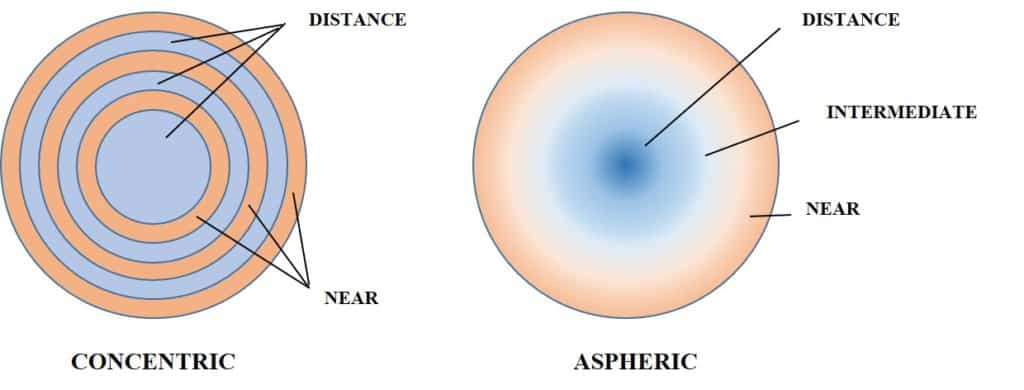
Multifocal Contact Lenses
August 3, 2020

Did you know there are contact lenses specifically designed for people who need reading glasses? Multifocal contacts provide clear vision at distance, intermediate, and near without the need to solely rely on reading glasses for near activities.
Presbyopia + Multifocals
Around age 40, the focusing system begins the inevitable process of presbyopia. This is when it becomes difficult to read small print up close. While the timing and severity is different for each individual, it is something that everyone will experience. In order to alleviate the eyestrain and blur when reading, some people turn to progressive lenses, bifocals, or reading glasses. What you might not know is that there are multifocal contact lenses, which are an excellent option too.
Multifocal describes the multiple areas of focus that are involved in the contacts. Similar to progressive (“no-line bifocal”) glasses, the contacts contain a range of three prescriptions (distance, intermediate, and near) blended into one lens.
Benefits of Multifocal Contact Lenses
The most notable benefit of multifocal contacts is the ability to perform every day activities without the burden of depending on reading glasses for anything within arm’s reach. This means you can read text messages, emails, price tags, nutrition labels, and menus – only to name a few of the countless things we look at on a regular basis. People love the freedom of not needing ten pairs of reading glasses scattered throughout the house, car, and purse.
Lens Design
There are two main types of multifocal lens designs: concentric and aspheric. The concentric design is created using alternating, concentric rings of distance and near powers. Most brands provide a choice of distance-center or near-center, which helps the optometrist refine the prescription based on an individual’s visual demands. An aspheric multifocal works by having either the distance or near power in the center and the prescription gradually changes moving towards the outside of the lens. Multifocal lenses are available in both monthly and daily disposable options, making it a worthy choice even for part-time contact lens wearers.

Multifocal Lenses for Almost Everyone
With a wide variety of available prescriptions, there is a multifocal contact lens for almost everyone. While the transition to a multifocal lens is easier for someone who already wears contacts, it is not a requirement. First-time contact lens wearers, previous contact lens wearers, and existing wearers can all benefit from the multifocal technology. Even if you don’t wear glasses for the distance, there are still multifocal contacts available with little to no prescription for the distance. This is a convenient option for people on the move, who don’t want the hassle of going on and off with reading glasses throughout the day.
Adapting to Multifocals
Unlike progressive glasses, there is no conscious effort of the wearer to look through the correct part of the lenses. The visual system adapts and learns to focus through the appropriate power for the situation at hand, while ignoring the irrelevant powers. This requires patience for new multifocal lens wearers, as the process may take several days to notice an improvement. Multifocal contacts work better in normal or full-lighted environments. If the pupil dilates in a dim setting, it may be difficult for the brain to properly navigate the different powers of the multifocal lens. In these occasional scenarios, it is best to increase the lighting or use a pair of reading glasses over the contacts if you are unable to control the room brightness.
Multifocals Versus Monovision
You may have heard of the term, monovision, once you reached the point of needing reading glasses over your contact lenses. Before the creation of multifocal contacts, monovision was the only way to help a person read at near without using reading glasses. Monovision uses a single vision lens to correct one eye (usually the dominant eye) for distance and the other eye for near. In theory, the brain will use whichever eye is clear for the given distance and ignore the blurred eye. While some people do well with this setup, others are unable to adapt. A major downfall of monovision is the lack of depth perception. Depth perception is affected because the eyes are working independently of one another instead of both eyes clearly viewing the object at the same time. Contrarily, multifocal lenses provide clear vision for both eyes at distance, intermediate, and near without negatively affecting depth perception.
If you think you could benefit from multifocal contact lenses, ask your eye doctor about them at your next comprehensive eye exam. We are happy to discuss solutions to presbyopia that do not require reading glasses for all near tasks. Call our office or schedule online!